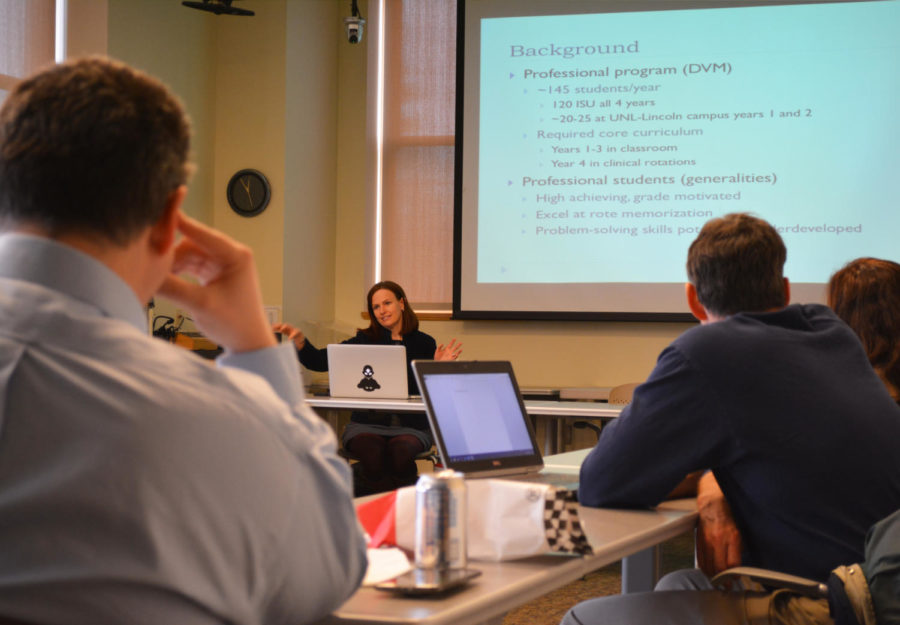Instructors see benefits, drawbacks to Top Hat
Katlyn Campbell/Iowa State Daily
Shannon Hostetter, assistant professor in veterinary medicine, tells a group of faculty members how she uses Top Hat in her classes during the second installment of a seminar focused on Top Hat at Morrill Hall on Mar. 23.
March 23, 2017
In the spring of 2017, Iowa State had 11,150 student users and 171 instructor users on Top Hat.
It was a surprise to many students when it was announced that the clickers would be replaced with a whole new site. However, many Iowa State faculty seem to like the system in their large classes.
A group of about 20 Iowa State faculty met Thursday at Morrill Hall to discuss the fundamentals of using Top Hat. The seminar, “Top Hat Learning Community,” was led by Cristina Bonaccorsi, chemistry lecturer, and Lesya Hassall, Center for Excellence in Learning and Teaching program coordinator. Speakers Shannon Hostetter, assistant professor of veterinary medicine, and Beth Caissie, assistant professor of geology and atmospheric sciences, joined them.
Top Hat is a web-based teaching platform that replaced students’ clickers. With Top Hat, students can log in to their account on their computers, phones and tablets to view teachers’ presentations, participate in live polls, take quizzes and track attendance.
The beginning of the seminar began with a slide on important formalities for instructors using Top Hat. The University Bookstore must be notified if Top Hat is being used in a course, whether students are participating via subscription or for free.
Instructors are also allocated royalties if they opt to author content in Top Hat slides, question packs, articles and course packs.
Despite Top Hat’s successes, some faculty have been experiencing problems with transferring their data from Top Hat’s system to Blackboard. The seminar showed attendees ways to successfully implement Top Hat into their classes.
Hostetter teaches clinical pathology at Iowa State and although she was initially wary of using Top Hat because of a poor demonstration on the web-based teaching system, she has found success using it.
“I’ll be honest, I really didn’t want to use Top Hat,” Hostetter said. “… I’ll admit that my first semester using it, it’s very much improved from that first demonstration. It’s very intuitive from an instructor standpoint. I haven’t had any complaints from the students about using it as an engagement facility.”
Caissie has had “the exact opposite” experience with Top Hat. Caissie teaches team-based learning in her introductory geology class with the use of Top Hat. Caissie noted account sharing, cost, the team column in the grade book, grade export and software changes as frustrations she’s had with Top Hat.
“One of my frustrations that I have with [Top Hat] are some of the changes they have made make it more difficult to use,” Cassie said. “… I’m always in the classroom like, ‘Oh, and Top Hat’s not working the way I expected it to again.’”
Using Top Hat for team purposes has been prone to difficulty, with students often not listening to how their instructors want them to respond to online questions. A few faculty members said they have teams put “Team 1,” “Team 2,” etc. before answering the question so they can be held accountable for the response.
One limitation of Top Hat exists with the word-style questions in instructor’s slides. If the student’s response is not exactly the same as the instructor’s, they will miss the question. In this instance, instructors must go in and hand grade all answers submitted.
In addition, Ann Smiley-Oyen, associate professor of kinesiology, said that with Top Hat, “theoretically [students] can be on their phones at home answering questions.”
This is not desired for instructors because students can gain points even if they skip class.
To troubleshoot this, Smiley-Oyen provides the quiz question on PowerPoint and only releases answer “A,” “B,” “C,” “D,” etc. on Top Hat so students at home don’t have context to which answers correspond with the letters.
To further discuss Top Hat, there will be another seminar on Apr. 26.

















